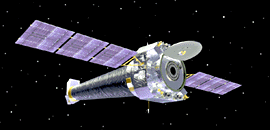STS-93 Readies for Lift-Off with Chandra Observatory
STS-93 Readies for Lift-Off with Chandra Observatory
| 28 January 1999 |
The next Shuttle flight will occur sometime in the Spring of 1999, and carry in its payload bay NASA's next X-ray astronomy satellite. The exact date for launch is not yet determined due to a recent delay, but it will occur no earlier than April 8. This flight will also be the first time a woman astronaut, US Air Force Colonel Eileen Collins, will serve as the Flight Commander. STS-93 will be the 94th Space Shuttle flight, and the 26th flight for the orbiter Columbia.
 Credit: NASA |
| NASA's Chandra X-ray Observatory |
The primary objective of STS-93 is to deploy the Chandra X-ray Observatory. The Chandra X-ray Observatory was created to conduct comprehensive studies of the Universe at X-ray wavelengths with images 25 times sharper than previously possible. Chandra's improved sensitivity will make possible more detailed studies of black holes, supernovae, and dark matter; it will increase our understanding of the origin, evolution, and destiny of the Universe. Chandra consists of three major elements: a spacecraft with an inertial upper stage rocket motor, a telescope, and a science instrument module.
NASA recently announced that it would delay January's planned shipment of the Chandra X-ray Observatory from prime contractor TRW Space and Electronics Group to NASA's Kennedy Space Center. The postponement will allow TRW to evaluate and correct a potential problem with several printed circuit boards in the observatory's command and data management system. TRW notified NASA of a potential problem last week after another spacecraft being built by the company experienced a failure during testing that was attributed to similar printed circuit boards. The problem has been traced to poor conductivity between different layers of the boards. The boards are used in Chandra's main command and telemetry unit, as well as in four remote units. These units provide command and data communications links between the observatory's computer and subsystems. NASA has directed TRW to remove and replace the boards in the main unit, and to conduct further tests and evaluation to determine if it is also necessary to replace the boards in the remote units. The repair, if limited to boards in the main command and telemetry unit, is expected to delay shipment to Kennedy by approximately one week. This will result in approximately a five-week slip in the observatory's launch readiness date, in order to allow for integration and testing of the units at Kennedy. If boards in the remote units must also be replaced, a more extensive slip is anticipated.
NASA's premier X-ray observatory was recently named the Chandra X-ray Observatory in honor of the late Indian-American Nobel laureate, Subrahmanyan Chandrasekhar. This occurred after a naming contest which attracted 6,000 entries from fifty states and sixty-one countries. The winning name and essays, and the runner-up names and essays, were decided by an elite panel that included prominent scientists, a space science executive, and nationally recognized science reporters. Chandrasekhar (1910-1995), known to the world as Chandra (which means "moon" or "luminous" in Sanskrit), is widely regarded as one of the foremost astrophysicists of the twentieth century.

